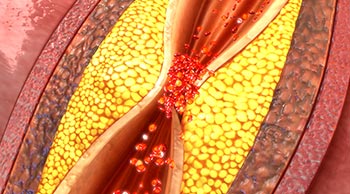What is Coronary Artery Disease
 Coronary artery disease develops when the major blood vessels that supply your heart become damaged or diseased. The coronary arteries supply blood, oxygen, and nutrients to your heart. A buildup of plaque can narrow these arteries, decreasing blood flow. The reduced blood flow can cause chest pain (angina), shortness of breath, or other symptoms. A heart attack can happen when there is a complete blockage of the arteries.
Coronary artery disease develops when the major blood vessels that supply your heart become damaged or diseased. The coronary arteries supply blood, oxygen, and nutrients to your heart. A buildup of plaque can narrow these arteries, decreasing blood flow. The reduced blood flow can cause chest pain (angina), shortness of breath, or other symptoms. A heart attack can happen when there is a complete blockage of the arteries.
If your coronary arteries narrow, they can’t supply enough oxygen-rich blood to your heart — especially when it’s beating hard, such as during exercise. At first, the decreased blood flow may not cause any symptoms.
Symptoms
As plaque continues to build up in the arteries, you may develop the following signs and symptoms:
- Chest pain (angina) – Pressure or tightness in the middle or left side of the chest, triggered by physical or emotional stress, which usually goes away within minutes after stopping the stressful activity. Women may feel sharp pain in the neck, arm or back.
- Shortness of breath
- Heart attack – Classic signs and symptoms of a heart attack include crushing pressure in your chest and pain in your shoulder or arm, sometimes with shortness of breath and sweating. Women may have neck or jaw pain, shortness of breath, fatigue and nausea.
Possible Causes
Coronary artery disease begins with damage or injury to the inner layer of a coronary artery, sometimes as early as childhood. The damage may be caused by:
- Smoking
- High blood pressure
- High cholesterol
- Diabetes or insulin resistance
- A sedentary lifestyle
Risk Factors
Risk factors for coronary artery disease include:
- Age
- Gender – in general, men are at greater risk, but after menopause, the risk increases for women
- Family history
- Smoking
- High blood pressure
- High blood cholesterol levels
- Diabetes
- Obesity
- Physical inactivity
- High stress
- Unhealthy diet
- Sleep apnea
- High-sensitivity C-reactive protein (hs-CRP)
- High triglycerides
- Homocysteine
- Preeclampsia
- Alcohol use
- Autoimmune diseases
Complications
Coronary artery disease can lead to complications such as:
- Chest pain (angina)
- Heart attack
- Heart failure
- Abnormal heart rhythm (arrhythmia)
Prevention
To improve your heart health and prevent coronary artery disease:
- Quit smoking
- Control conditions such as high blood pressure, high cholesterol, and diabetes
- Stay physically active
- Eat a low-fat, low-salt diet that’s rich in fruits, vegetables, and whole grains
- Maintain a healthy weight
- Reduce and manage stress